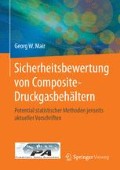Zusammenfassung
Es wird zunächst kurz auf die Speicherung von Gasen in Druckbehältern aus Verbundwerkstoffen eingegangen. Die verschiedenen Bauweisen und grundlegende Begrifflichkeiten werden erläutert und ein kurzer historischer Abriss zur Entwicklung der internationalen Vorschriften wird gegeben, ausgehend von den nationalen Vorschriften in Deutschland. Danach werden die fünf zentralen Aspekte dieses Buches, mit den jeweils zugehörigen Neuerungen kurz vorgestellt und so auf das jeweilige Kapitel verwiesen, das sich einem dieser Themen im Detail widmet. Diese sind kritische Gedanken zur Bedeutung des Berstdruck s für die Betriebsfestigkeit, der Aspekt der baumusterspezifischen Eigenschaft der Lastwechselempfindlichkeit, die zentralen Möglichkeiten, Restfestigkeiten zu messen, eine kurze Einführung zur langsamen Berstprüfung, erste Gedanken zum probabilistische Ansatz.
Access this chapter
Tax calculation will be finalised at checkout
Purchases are for personal use only
Literatur
Druckbehälterverordnung (DruckbehV) (1980),
ADR/RID (2015) Techncial annexes to the European agreements concerning the international carriage of dangerous goods. (2014)
Boellinghaus THK, Mair GW, Grunewald T (2014) Explosion of iron hydrogen storage containers – Investigations from 120 years ago revisited. Eng Fail Anal 43:47–62. doi:10.1016/j.engfailanal.2014.03.017
Winter CJ, Nitsch J (1986) Wasserstoff als Energieträger. Springer, Berlin
Bölkow L. (1987) Energie im nächsten Jahrhundert. S. 24
Albrecht U, et al (2013) Analyse der Kosten Erneuerbarer Gase – Eine Expertise für den Bundesverband Erneuerbare Energie, den Bundesverband Windenergie und den Fachverband Biogas. Bd. 978-3-920328-65-2 S. 54. Bochum
Ag L (2014) An introduction to the cleanest energy carrier. In: Hydrogen. Linde AG Linde Gas Division, Munich. http://www.linde-gas.com/en/news_and_media/publications
HyWays: HyWays Roadmap – the European hydrogen energy roadmap
Tsai SW (1987) Composites design, 3rd ed. Think Composites, Dayton
Schürmann H (2007) Konstruieren mit Faser-Kunststoff-Verbunden: Mit 39 Tabellen, 2., bearb. und erw. Aufl. Aufl. VDI. Springer, Berlin
Hinton MJ, Kaddour AS, Soden PD (2004) Failure criteria in fibre reinforced polymer composites: the World-Wide Failure Exercise. Elsevier, Amersterdam
Knops M (2010) Analysis of failure in fiber polymer laminates: the theory of Alfred Puck, Corr, 2. print Aufl. Springer, Berlin
Agreement concerning the adoption of uniform technical prescriptions for wheeled vehicles, equipment and parts which can be fitted and/or be used on wheeled vehicles and the conditions for reciprocal recognition of approvals granted on the basis of these prescriptions (1958) 1958-Agreement
Regulation 67 (2012) Concerning the adoption of uniform technical prescriptions for wheeled vehicles, equipment and parts which can be fitted and/or be used on wheeled vehicles and the conditions for reciprocal recognition of approvals granted on the basis of these prescriptions. ECE R67. UN ECE
Regulation 110 (2014) Uniform provisions concerning the approval of: I. Specific components of motor vehicles using compressed natural gas (CNG) and/or liquefied natural gas (LNG) in their propulsion system II. Vehicles with regard to the installation of specific components of an approved type for the use of compressed natural gas (CNG) and/or liquefied natural gas (LNG) in their propulsion system. ECE R110. UN ECE
Straßenverkehrs-Zulassungs-Ordnung straßenverkehrsrechtlicher Vorschriften (2014) StVZO, Bd. 2014. Bd. Teil I Nr. 15, S. 348
Mair GW (1996) Zuverlässigkeitsrestringierte Optimierung faserteilarmierter Hybridbehälter unter Betriebslast am Beispiel eines CrMo4-Stahlbehälters mit Carbonfaserarmierung als Erdgasspeichers im Nahverkehrsbus. Bd. Fortschrittsbericht Reihe 18. VDI-Verlag, Düsseldorf
Pauchard V, Chateauminois A, Grosjean F, Odru P (2002) In situ analysis of delayed fibre failure within water-aged GFRP. Int J Fatigue 24:447–454
Newhouse NL, Webster C (2008) Data supporting composite tank standards development for hydrogen infrastructure applications: STP-PT-014. ASME Standards Technology, LLC, New York
Robinson EY (1991) Design prediction for long-term stress rupture service of composite pressure vessels. The Aerospace Corporation, El Segundo
Mair GW, Pöschko P, Schoppa A (2011) Verfahrensalternative zur wiederkehrenden Prüfung von Composite-Druckgefäßen. Tech Sicherh 1(7/8):38–43
Mair GW, Hoffmann M, Schoppa A, Spode M (2012) Betrachtung von Grenzwerten der Restfestigkeit von Composite-Druckgefäßen: Teil 1: Kriterien der hydraulischen Lastwechselprüfung. Tech Sicherh 2(7/8):30–38
European Parliament (2010). Regulation (EU) No 406/2010 Implementing Regulation (EC) No 79/2009 of the European parliament and of the council on type-approval of hy-drogenpowered motor vehicles. Brussels
Mair GW et al (2013) Abschlussbericht zum Vorhaben „Ermittlung des Langzeitverhaltens und der Versagensgrenzen von Druckgefäßen aus Verbundwerkstoffen für die Beförderung gefährlicher Güter“. BMVBS UI 33/361.40/2–26 (BAM-Vh 3226). Berlin
Mair GW, Duffner E, Schoppa A, Szczepaniak M (2011) Aspekte der Restfestigkeitsermittlung von Composite-Druckgefäßen mittels hydraulischer Prüfung. Tech Sicherh 1(9), 50–55
Author information
Authors and Affiliations
Corresponding author
Rights and permissions
Copyright information
© 2016 Springer-Verlag Berlin Heidelberg
About this chapter
Cite this chapter
Mair, G. (2016). Einführung. In: Sicherheitsbewertung von Composite-Druckgasbehältern. Springer Vieweg, Berlin, Heidelberg. https://doi.org/10.1007/978-3-662-48132-5_1
Download citation
DOI: https://doi.org/10.1007/978-3-662-48132-5_1
Published:
Publisher Name: Springer Vieweg, Berlin, Heidelberg
Print ISBN: 978-3-662-48131-8
Online ISBN: 978-3-662-48132-5
eBook Packages: Computer Science and Engineering (German Language)

